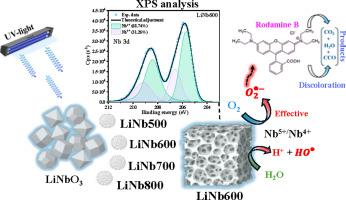改性溶胶-凝胶合成LiNbO3: Rietveld精制、形貌、光学性质及对RhB染料的高光催化性能
IF 9.2
2区 工程技术
Q1 ENERGY & FUELS
引用次数: 0
摘要
在这项研究中,我们首次报道了在模拟紫外光下,在500°C (LiNb500)和800°C (LiNb800)之间改变煅烧温度,利用改进的Pechini方法成功地获得了多相混合LiNbO3对罗丹明B (RhB)染料的高光催化性能。采用热重分析/差热重分析(TG/DTG)、x射线衍射(XRD)和Rietveld细化、拉曼光谱、漫反射紫外-可见光谱、能量色散x射线能谱(EDS)扫描电镜(SEM)、光致发光(PL)光谱、透射电镜(TEM)、x射线光电子能谱(XPS)、BET比表面积和孔隙体积等方法对制备的材料进行表征。结果表明,热处理的影响导致了LiNb500的纯相的获得。在等于或高于600°C的温度下,观察到LiNb3O8的次要次级相(2.82% ~ 4.2%)。光学表征表明,LiNb500样品具有较强的发光能力,这是由于基体与残余碳的协同作用,而通过提高热处理温度消除碳而抑制了其他样品的发光效果。另一方面,对LiNbO3基体中元素的化学状态进行了XPS分析,发现LiNb600样品的纳米晶体表面Nb4+的比例高于Nb5+,以及与氧空位相关的化学状态。这些特性改善了光催化性能。在这种情况下,它促进了100%的RhB(10毫克)的变色。紫外光照射60min后的L−1)。通过对光生活性物质的清除剂研究,证实了超氧自由基和空穴是参与RhB染料分子变色的主要物质,其中光催化剂试验中缺氧导致染料分子变色减少35.39%。另外,在重复使用试验中,连续5次循环90 min后,效率超过91%。因此,LiNbO3多晶在持久性有机污染物的光降解中表现出协同和有希望的性能。本文章由计算机程序翻译,如有差异,请以英文原文为准。

Modified Sol-gel synthesis of LiNbO3: Rietveld refinement, morphology, optical properties and high photocatalytic performance over RhB dye
In this study, we report for the first time that a high photocatalytic performance of multiphase mixed LiNbO3 was successfully obtained using a modified Pechini method, varying the calcination temperatures between 500 °C (LiNb500) and 800 °C (LiNb800), against the Rhodamine B (RhB) dye under simulated ultraviolet light. The produced materials were characterized by Thermogravimetric analysis/Difference thermal gravimetry (TG/DTG), X-ray diffraction (XRD) and Rietveld refinement, Raman spectroscopy, UV–Vis by diffuse reflectance, Scanning electron microscopy (SEM) with energy dispersive X-ray spectroscopy (EDS), Photoluminescence (PL) spectroscopy, Transmission electron microscopy (TEM), X-ray photoelectron spectroscopy (XPS), and the surface area and pore volume by BET. Based on the results, it is confirmed that the influence of heat treatment leads to the obtaining of a pure phase for LiNb500. At temperatures equal to or higher than 600 °C, minor secondary phases of LiNb3O8 (2.82 % to 4.2 %) were observed. The optical characterization revealed strong luminescent emission for the LiNb500 sample, resulting from the synergistic effect of the matrix with the residual carbon, and suppression of the luminescent effect for the other samples caused by the elimination of carbon by increasing the heat treatment temperature. On the other hand, the XPS analysis of the chemical states of the elements present in the LiNbO3 matrix revealed that the LiNb600 sample has a higher percentage of Nb4+ than Nb5+ species on the surface of the nanocrystals, compared to the others, as well as chemical states related to oxygen vacancies. These characteristics provided improvements in photocatalytic performance. In this case, it promoted the discoloration of 100 % of RhB (10 mg.L−1) after 60 min of exposure time under UVc light. Through the scavenger study for reactive species photogenerated, it is confirmed that the superoxide radicals and holes are the main species involved in the discoloration of RhB dye molecules, where the absence of oxygen in the photocatalyst test resulted in a decrease of 35.39 %. In addition, after the five consecutive cycles of 90 min in the reuse test, the efficiency exceeded 91 %. Thus, the LiNbO3 polymorphs exhibit a synergistic and promising performance in the photodegradation of persistent organic pollutants.
求助全文
通过发布文献求助,成功后即可免费获取论文全文。
去求助
来源期刊

Sustainable Materials and Technologies
Energy-Renewable Energy, Sustainability and the Environment
CiteScore
13.40
自引率
4.20%
发文量
158
审稿时长
45 days
期刊介绍:
Sustainable Materials and Technologies (SM&T), an international, cross-disciplinary, fully open access journal published by Elsevier, focuses on original full-length research articles and reviews. It covers applied or fundamental science of nano-, micro-, meso-, and macro-scale aspects of materials and technologies for sustainable development. SM&T gives special attention to contributions that bridge the knowledge gap between materials and system designs.
 求助内容:
求助内容: 应助结果提醒方式:
应助结果提醒方式:


